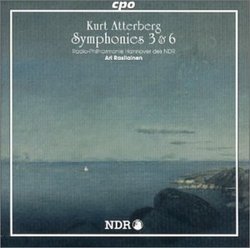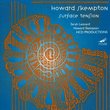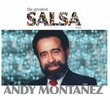| All Artists: Kurt Atterberg, Ari Rasilainen, Hannover Radio Symphony Orchestra, NDR Philharmonic Orchestra (Hannover), Radio-Philharmonie Hannover des NDR Title: Kurt Atterberg: Symphonies Nos. 3 & 6 Members Wishing: 0 Total Copies: 0 Label: Cpo Records Release Date: 9/26/2000 Genre: Classical Styles: Historical Periods, Modern, 20th, & 21st Century, Symphonies Number of Discs: 1 SwapaCD Credits: 1 UPC: 761203964024 |
Search - Kurt Atterberg, Ari Rasilainen, Hannover Radio Symphony Orchestra :: Kurt Atterberg: Symphonies Nos. 3 & 6
 | Kurt Atterberg, Ari Rasilainen, Hannover Radio Symphony Orchestra Kurt Atterberg: Symphonies Nos. 3 & 6 Genre: Classical
|
Larger Image |
CD DetailsSimilar CDs
|
CD ReviewsA strong series of advocacy for an enticing composer David A. Hollingsworth | Washington, DC USA | 02/10/2002 (5 out of 5 stars) "The curiosity and the pioneer of the works of Kurt Atterberg (1887-1974) came relatively late in comparison to his near Swedish contemporaries, like Peterson-Berger, Rangstrom, Allan Pettersson, Alfven, and Stenhammar. Thankfully, we are still in the age where discovery and re-discovery of obscure masterworks are still being undertaken. It's true that recordings of his works were made especially after the 1940s, thanks to Beecham, Westerberg, et al. But recordings and performances of his music were sporadic and there had never been a consistent advocate and pioneer of his works....until now.How to describe Atterberg's music? Like Bax, he never abandon the spirit and the blazing glory of the Romantic Age. Atterberg shares with Bax (and even Tubin, Strauss, and Vaughn-Williams) the ability for imaginative and compelling orchestration, and the ability to evoke the picturesque quality of his music making to high effectiveness. As in Rangstrom, Atterberg's orchestration can occasionally be coarse-grained and overcooked. But rarely does Atterberg cause my attention to shift elsewhere. His works in general, especially the symphonies, evince a strong feeling for form and proportion. They are highly inventive and vital, and Atterberg's constant use of Swedish folkmusic added further dimensions and facets to his music. The rhetoric is sometimes Baxian (like the ending of the Third Symphony), but rewardingly idiomatic and self-assuring.The Third Symphony "Vastkustbilder" (or West Coast Pictures) is highly imaginative, inventive, and ultimately inspirational. The first movement (Lento) "Sun Smoke" begins solemnly and soon the atmosphere have magic. Atterberg economized used of the orchestra helps to evoke wonder. But, the music does not travel as far as the first movement in Tubin's Second Symphony, where that subdue magic gave way to an explosive climax lending to the second movement. The con fuoco second movement "Storm" is somewhat overscored, but it's very cinematic. But force me to decide what movement is the best and I'll emphatically claim the finale "Summer Night." I admire the orchestration that again evokes wonder. But the buildup into a very inspirational closing, though a bit flawed, is nevertheless genuine and compelling (that even Strauss would have greatly admire): the final three minutes convey ingenuity and depth.The Sixth Symphony of 1927-1928 is sometimes nicknamed the "Dollar Symphony" due to the $10,000 prize Atterberg won in an international competition sponsored by the Columbia Gramophone Company of New York (he later used it to buy a car). It was during the occasion commemorating the centenary of Schubert's death. The work was adversely affected by a stir created by Olin Downes, an influential American critic who deemed the work as plagiaristic. But the symphony made Atterberg an internationally known figure thanks largely to both the advocacies of Beecham and Toscanini. The symphony possess a genuine sweep (especially in the first movement). But the second movement, in the worlds of Nielsen and Arnold in places, is quite a masterpiece. It have a rather strong nationalistic feeling to it mixed in with subdued eloquence and passion (the beginning with muted strings and clarinet solo is especially enticing). The finale, somewhat a rondo, is robust and conveys an innocent sense of gaiety. The performance also provided me with reasons not to look the other way (instead I play the CD on four occasions in the past three days). The Finnish conductor, Ari Rasilainen, draws from the Radio Philharmonic Hannover of NDR every ounce of authority, vividness, imagination, and commitment. Rasilainen's choice in tempi, phrasing, and articulation is wholeheartedly ideal. I wonder, though, why a Swedish orchestra is not yet featured in this seemingly ongoing CPO series of Atterburg's works. But, never mind, for now. The German orchestras thus far in this series serve the music well enough and more, as does Rasilainen."
|

 Track Listings (6) - Disc #1
Track Listings (6) - Disc #1



